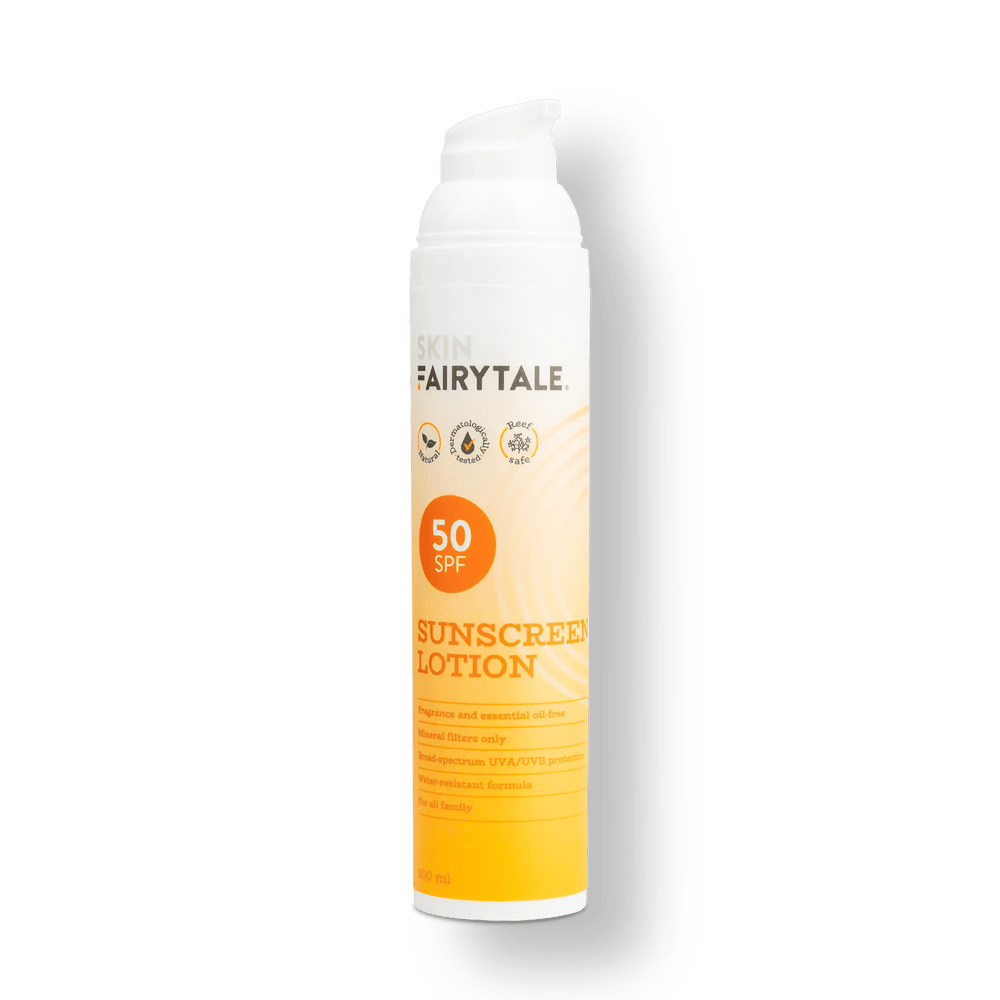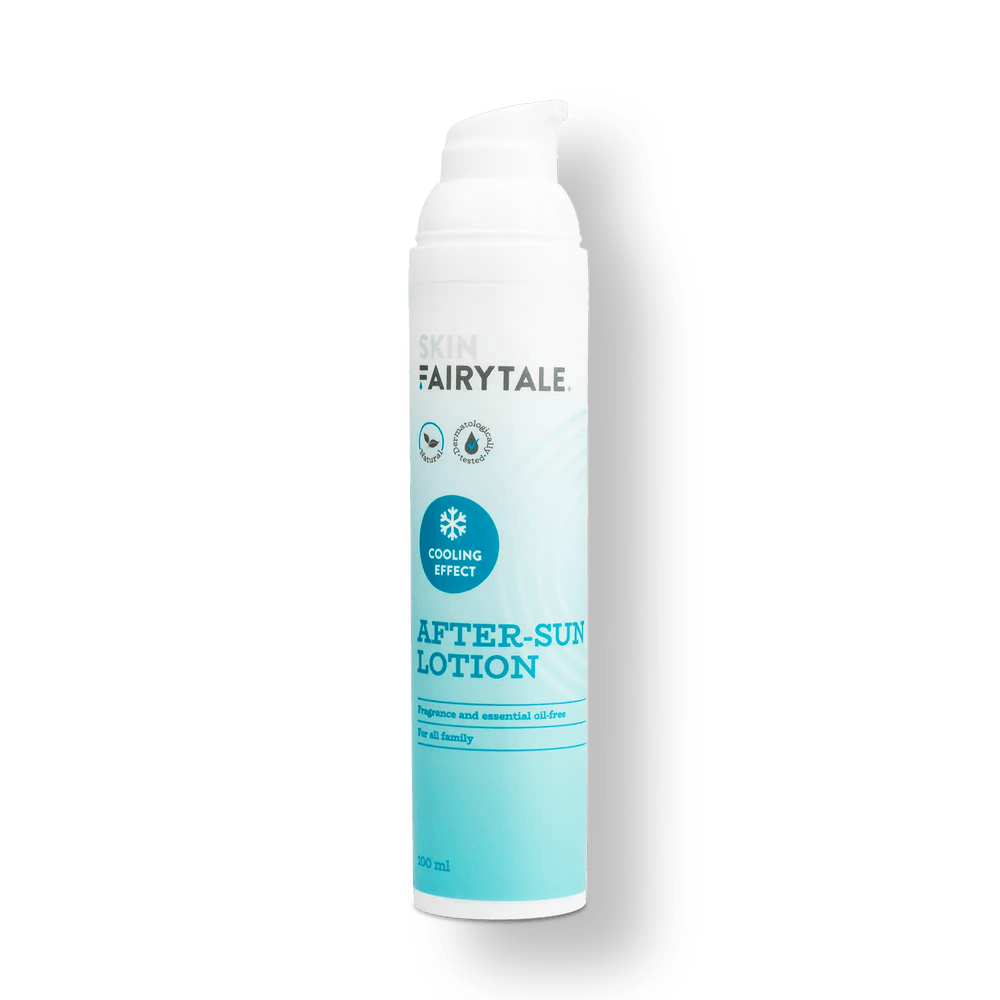UV filters
Repeated exposure to UV radiation plays a significant role in aging, immunosuppression (inhibition of the normal functioning of the immune system), skin cancer, and exacerbation of photodermatoses (skin diseases caused by sunlight). According to the Skin Cancer Foundation, 90% of all non-melanoma skin cancers and 86% of melanomas are caused by sun exposure.
That's why we think sun protection is very important, what about you?
Sun protection is not just sunscreen, but also hats, sunglasses, and clothing that protect us from the sun's rays.
In our blog post about sunscreens, we explained the basics of sun protection and the differences between mineral and chemical filters. We busted myths about the claims that appear in the world of sunscreens. If you haven't already, I suggest you read this blog first: ARE SUNSCREEN REALLY HARMFUL?
White elegance?
If you're worried about the white cast left by mineral or physical filters, TERNA! The most useful, well-known and safe are titanium dioxide and zinc oxide. A combination of the two is usually used, as this provides broad-spectrum protection, i.e. UV-A and UV-B.
Scientists agree that these two filters are the best at protecting our skin and do not irritate it. It is true that zinc oxide makes the formulation look like a white paste, while titanium dioxide additionally "whitens" the cream. Although we can micronize the particles (by reducing the particles, the white trace that the cream should leave disappears), we will still not achieve the same result as if we used chemical filters that do not leave a white trace. In addition, mineral sunscreens are even more expensive and formulating them is even more difficult, since mineral filters are poorly soluble.
What looks more aesthetically pleasing?
Chemical filters! But they are less effective at protecting against the sun if used individually, so a combination of several is needed to achieve the desired broad-spectrum protection. The filters that are most commonly used and found in two-thirds of all sunscreens with chemical filters in America are oxybenzone and octinoxate. The fact that these filters are potentially allergenic and are absorbed into our bodies has raised concerns, but what has raised the most dust is the impact on the environment. In fact, oxybenzone was declared the allergen of the year in America in 2014, and in the European Union, most of the filters have already been replaced.
Coral bleaching
Oxybenzone, octocrylene, octinoxate and ethyl hexyl salicylate are said to cause coral bleaching. In addition, oxybenzone and octinoxate are not only used in sunscreens, but also in personal care products. In Hawaii, they have restricted the use of these two ingredients, especially near beaches. Namely, it is estimated that approximately 25% of sunscreen is washed off after 20 minutes, which represents between 4,000 and 6,000 tons of sunscreen per year. Corals need a protective environment, a special type of algae and ingredients for photosynthesis to survive. The algae are separating from the coral, which consequently increases the possibility of coral diseases and so coral reefs are slowly literally disappearing.
How do we interpret studies?
They have proven that oxybenzone has an effect on androgenic and estrogenic hormones with chronic exposure to this filter. The study was conducted on fish and rats, which were given the filter orally. The interesting fact is that it would take 35 years to reach the same amounts that were found in the animals if you applied 2 mg/cm2 to your entire body daily. However, we apply the cream in smaller amounts than necessary and use it maybe 1 month a year, and then only in rare cases. In other words, it is difficult to reach such levels as in the study and therefore the use of creams with these filters is still safe, even though at first glance it seems that they are not.
Atypical sun protection options
Tropical fern, niacinamide and alphamelanotide (an analogue of the hormone that stimulates melanocytes). They mainly have antioxidant and anti-inflammatory effects, preventing the formation of actinic keratosis and other photodermatoses. In short, they mitigate the damage that we can suffer from sun exposure.
Table of newer/most common/physical UV filters
| Commercial name | INCI | Spectrum | Permitted concentration | Physical/chemical |
| Zinc oxide | Zinc oxide | UV-A1, UV-A2, UV-B | Up to 25% | Physical |
| Oxybenzone | Benzophenone-3 | UV-A2, UV-B | Up to 10% | Chemical, common |
| Eusolex / Octisalate | Ethylhexyl Salicylate | UV-B | Up to 5% | Chemical, newer |
| Ethylhexyl methoxycinnamate/ octinoxate | Ethylhexyl Methoxycinnamate | UV-B | Up to 10% | Chemical, common |
| Tinosorb M/ Bisoctrizol | Methylene Bis-Benzotriazolyl Tetramethylbutylphenol | UV-A1, UV-A2, UV-B | Up to 10% | Chemical, newer |
| Tinosorb S/ Bemotrizinol | Bis-Ethylhexyloxyphenol Methoxyphenyl Triazine | UV-A1, UV-A2, UV-B | Up to 10% | Chemical, newer |
| Titanium dioxide | Titanium dioxide | UV-A1, UV-B | Up to 25% | Physical |
| Twisted A | Diethylamino Hydroxybenzoyl Hexyl Benzoate | UV-A1 | Up to 10% | Chemical, newer |
| Twisted T | Ethylhexyl Triazone | UV-B | Up to 5% | Chemical, newer |
Newer filters
Bisoctrizol and bemotrizinol are very safe filters, they do not show allergenic effects and do not pass through the skin. Bisoctrizol belongs to the chemical and physical filters, as it reflects and absorbs light. Uvinula, on the other hand, is specific for UV-A and UV-B, does not irritate the skin and is neither phototoxic nor photosensitizing. All of these filters are very effective even at very low concentrations.
Nano-form mineral filters
There is a lot of controversy about the harmfulness of nano filters. Zinc oxide in particular in nano form is said to emit electrons that create free radicals, which damage DNA, lipids and proteins. In practice, however, all nanoparticles in sunscreens are coated with silica, which means that the amount of free radicals released into the environment is really limited. In addition, studies have also proven that nanoparticles do not pass through intact skin and mostly remain in the stratum corneum. A study in which they provided for the introduction of nano filters intravenously and subcutaneously has proven the low harmfulness of the filters. So, filters in nano forms are also safe.
Additional topical protection with antioxidants
Ingredients such as soy extract, vitamin C, vitamin E, grape seed oil, selenium, magnesium, algae extract, milk thistle, and tea polyphenols (green and black tea) have been shown to reduce the formation of reactive oxygen species. The combination of antioxidants in sunscreens is better for protection than sunscreens without antioxidants alone.
Literature:
Yeager, DG, Lim HW. What's New in Photoprotection. Dermatologic Clinics. 2019
Siller, A., Blaszak, SC, Lazar, M., & Olasz Harken, E. (2019). Update About the Effects of the Sunscreen Ingredients Oxybenzone and Octinoxate on Humans and the Environment. Plastic Surgical Nursing, 39(4), 157–160.
Monteiro-Riviere NA, Wiench K, Landsiedel R, et al. Safety evaluation of sunscreen formulations containing titanium dioxide and zinc oxide nanoparticles in UVB sunburned skin: an in vitro and in vivo study. Toxicol Sci. 2011;123:264–80
Fabian E, Landsiedel R, Ma-Hock L, et al. administered titanium dioxide nanoparticles in rats.
Arch Toxicol 2008;82:151–7. Tissue distribution and toxicity of intravenously
Schlumpf M, Cotton B, Conscience M, et al. In vitro and in vivo estrogenicity of UV screens. Environ
Health Perspective. 2001;109:239–44.
Wang SQ, Burnett ME, Lim HW. Safety of oxybenzone: putting numbers into perspective. Arch Dermatol. 2011;147:865–6.
Dunaway S, Odin R, Zhou L, et al. Natural antioxidants: multiple mechanisms to protect skin from solar radiation. Front Pharmacol. 2018;9:392.
Sánchez Rodríguez A, Rodrigo Sanz M, Betancort Rodríguez JR. Occurrence of eight UV fi lters in beaches of Gran Canaria (Canary Islands). An approach to environmental risk assessment. Chemosphere. 2015;131:85–90.
SCCP. Opinion on Diethylamino Hydroxybenzoyl Hexyl Benzoate ( https://ec.europa.eu/health/ph_risk/committees/04_sccp/docs/sccp_o_130.pdf )




